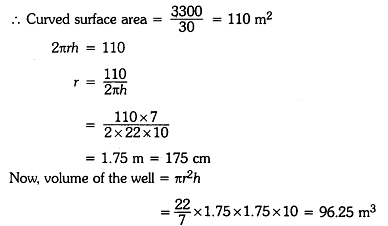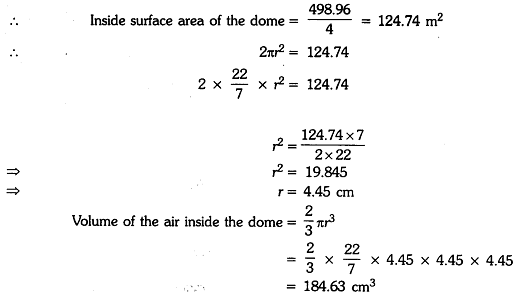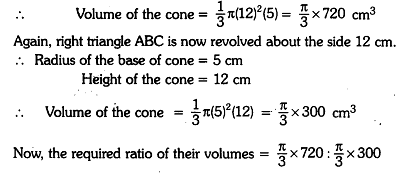Class 9 Maths Chapter 11 Question Answers - Surface Areas and Volumes
Q1: A spherical ball is divided into two equal halves. If the curved surface area of each half is 56.57 cm, find the volume of the spherical ball. [use π = 3.14]
Ans:
Since curved surface of half of the spherical ball = 56.57 cm2
2πr2 = 56.57
= 113.04 cm3
Q2: Find the capacity in litres of a conical vessel having height 8 cm and slant height 10 cm.
Ans:
Height of conical vessel (h) = 8 cm
Slant height of conical vessel (l) = 10 cm
∴ r2 + h2 = l2
⇒ r2 + 82 = 102
⇒ r2 = 100 – 64 = 36
⇒ r = 6 cm
Now, volume of conical vessel = 1/3πr2h
= 1/3 × 227 × 6 × 8
= 301.71 cm3
= 0.30171 litre
Q3: Calculate the surface area of a hemispherical dome of a temple with radius 14 m to be whitewashed from outside.
Ans:
Here, radius of hemispherical dome (r) = 14 m
Surface area of dome = 2πr2
= 2 × 22/7 × 14 × 14 = 1232 m2
Hence, total surface area to be whitewashed from outside is 1232 m2.
Q4: A rectangular piece of paper is 22 cm long and 10 cm wide. A cylinder is formed by rolling the paper along its length. Find the volume of the cylinder.
Ans:
Since rectangular piece of paper is rolled along its length.
∴ 2πr = 22
r = 22×7 / 2×22 = 3.5 cm
Height of cylinder (h) = 10 cm
∴ Volume of cylinder = πr2h
= 22/7 × 3.5 × 3.5 × 10 = 385 cm3
Q5: A heap of wheat is in the form of a cone whose diameter is 10.5 m and height is 3 m. Find it volume. If 1m3 wheat cost is ₹10, then find total cost.
Ans:
Diameter of cone = 10.5 m
Radius of cone (r) = 5.25 m
Height of cone (h) = 3 m
Volume of cone = 13πr2h
= 13 × 22/7 × 5.25 × 5.25 × 3
= 86.625 m3
Cost of 1m3 of wheat = ₹10
Cost of 86.625 m3 of wheat = ₹10 × 86.625
= ₹866.25
Q6: A cylindrical vessel can hold 154 g of water. If the radius of its base is 3.5 cm, and1cm3 of water weighs 1 g, find the depth of water.
Ans:
Since 1 cm3 of water weighs 1 g.
∴ Volume of cylindrical vessel = 154 cm3
πr2h = 154
22/7 × 3.5 × 3.5 × h = 154
h = 4cm
Hence, the depth of water is 4 cm.
Q7: A wall of length 10 m is to be built across an open ground. The height of the wall is 5 m and thickness of the wall is 42 cm. If this wall is to be built with brick of dimensions 42 cm × 12 cm × 10 cm, then how many bricks would be required?
Ans:
Here, length of the wall (L) = 10 m = 1000 cm
Breadth of the wall (B) = 42 cm
Height of the wall (H) = 5 m = 500 cm
∴ Volume of the wall = L × B × H
= 1000 × 42 × 500 cm3
Volume of each brick = 42 × 12 × 10 cm3
= 4167
Hence, the required number of bricks is 4167.
Q8: The volume of cylindrical pipe is 748 cm. Its length is 0.14 m and its internal radius is 0.09 m. Find thickness of pipe.
Ans:
Internal radius (r) of cylindrical pipe = 0.09 m = 9 cm
Length (height) of cylindrical pipe (h) = 0.14 m = 14 cm
Let external radius of the cylindrical pipe be R cm.
Volume of cylindrical pipe = 748 cm3
⇒ π(R2 – r2)h = 748
⇒ 22/7 (R2 – 92)14 = 748
⇒ R2 = 81 + 17 = 98
⇒ R = √98 = 7√2 cm = 9.9 cm
Thus, thickness of the pipe = 9.9 -9 = 0.9 cm
Q9: The curved surface area of a cylinder is 154 cm. The total surface area of the cylinder is three times its curved surface area. Find the volume of the cylinder.
Ans:
Since curved surface area of cylinder = 154 cm2 (given]
Total surface area of cylinder = 3 × curved surface area
2πrh + 2πr2 = 3 × 154 3 154 + 2πr2 = 462
2πr2 = 462 – 154 = 308
= 539 cm3
Q10: A right-angled ∆ABC with sides 3 cm, 4 cm and 5 cm is revolved about the fixed side of 4 cm. Find the volume of the solid generated. Also, find the total surface area of the solid.
Ans:
When rt. ∠ed ∆ABC is revolved about AB = 4 cm, it forms a right circular cone of radius 3 cm and height 4 cm. Slant height of the cone is 5 cm.
Q11: A semicircular sheet of metal of radius 14 cm is bent to form an open conical cup. Find the capacity of the cup.
Ans:
Radius of semicircular sheet (r) = 14 cm
∴ Slant height (1) = 14 cm
Circumference of base = Circumference of semicircular sheet
Q12: It costs ₹3300 to paint the inner curved surface of a 10 m deep well. If the rate cost of painting is of ₹30 per m2, find :
(a) inner curved surface area
(b) diameter of the well
(c) capacity of the well.
Ans:
Depth of well (h) = 10 m
Cost of painting inner curved surface is ₹30 per m2 and total cost is ₹3300
Hence, inner curved surface area is 110 m2, diameter of the well is 2 × 1.75 i.e., 3.5 m and capacity of the well is 96.25 m3.
Q13: Using clay, Anant made a right circular cone of height 48 cm and base radius 12 cm. Versha reshapes it in the form of a sphere. Find the radius and curved surface area of the sphere so formed.
Ans:
Height of cone (h) = 48 cm
Radius of the base of cone = 12 cm
Let R be the radius of sphere so formed
∴ Volume of sphere = Volume of cone
4/3πR3 = 1/3πr2h
4R3 = 12 × 12 × 48
R3 = 12 × 12 × 12
R = 12 cm
Now, curved surface area of sphere = 4πR2
= 4 × 22/7 × 12 × 12
= 1810.29 cm
Q14: A dome of a building is in the form of a hemisphere. From inside, it was whitewashed at the cost of ₹498.96. If the rate of whitewashing is ₹4 per square metre, find the :
(i) Inside surface area of the dome
(ii) Volume of the air inside the dome.
Ans:
Here, dome of building is a hemisphere.
Total cost of whitewashing inside the dome = ₹498.96
Rate of whitewashing = ₹4 per m2
Q15: A right triangle ABC with sides 5 cm, 12 cm and 13 cm is revolved about the side 5 cm. Find the volume of the solid so obtained. If it is now revolved about the side 12 cm, then what would be the ratio of the volumes of the two solids obtained in two cases ?
Ans:
Here, right triangle ABC with sides 5 cm, 12 cm and 13 cm is revolved about the side 5 cm.
∴ Radius of the base of cone = 12 cm
Height of the cone = 5 cm
= 12 : 5
Q16: A right triangle of hypotenuse 13 cm and one of its sides 12 cm is made to revolve taking side 12 cm as its axis. Find the volume and curved surface area of the solid so formed.
Ans:
Here, hypotenuse and one side of a right triangle are 13 cm and 12 cm respectively.
Now, given triangle is revolved, taking 12 cm as its axis
∴ Radius of the cone (r) = 5 cm
Height of the cone (h) = 12 cm
Slant height of the cone (1) = 13 cm
∴ Curved surface area = πrl = π(5)(13) = 65π cm2
Volume of the cone = 1/2πr2h = 1/2π × 5 × 5 × 12 = 100π cm3
Hence, the volume and curved surface area of the solid so formed are 100 π cm3 and 65 π cm2 respectively.
|
44 videos|412 docs|54 tests
|

|
Explore Courses for Class 9 exam
|

|


















